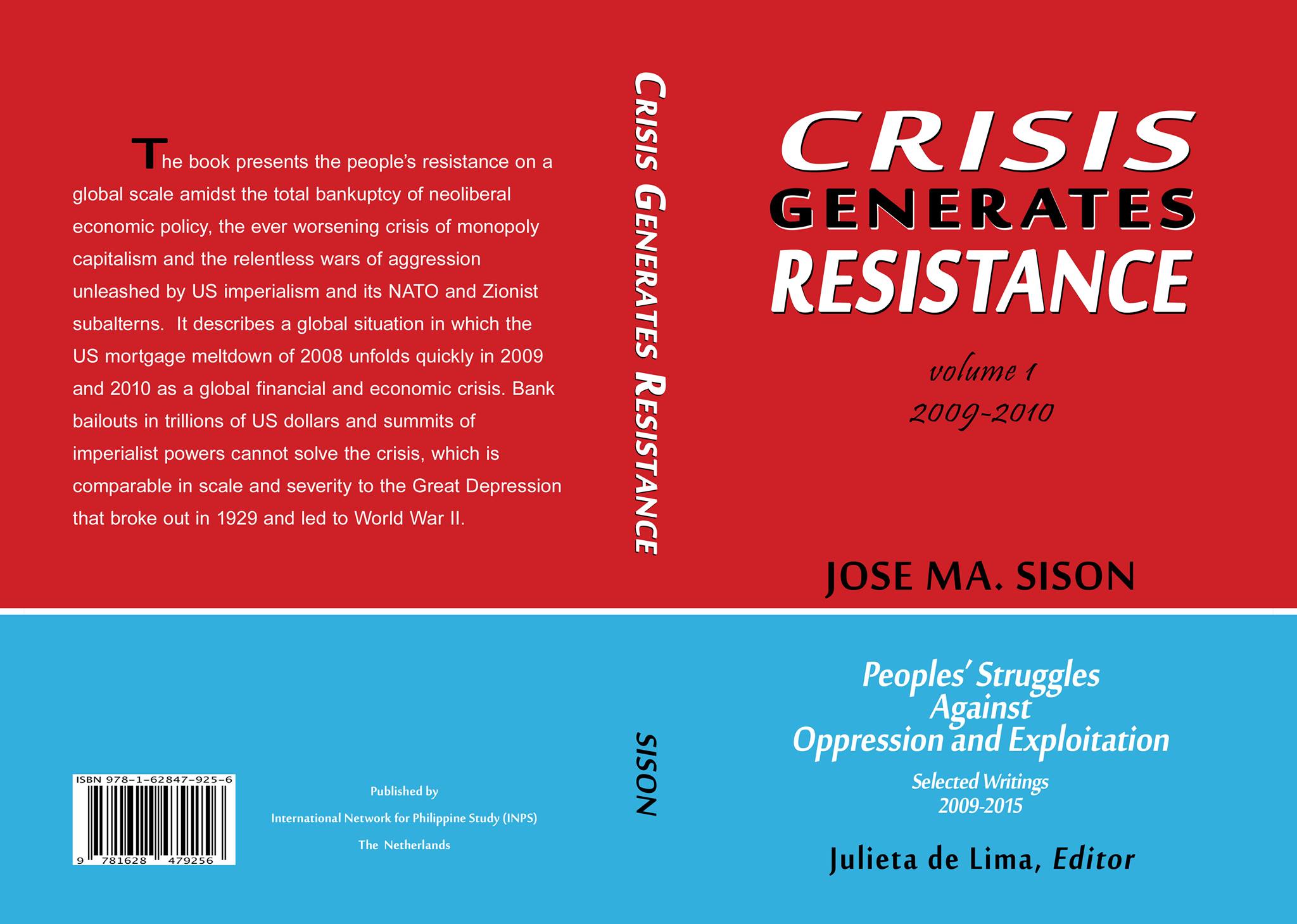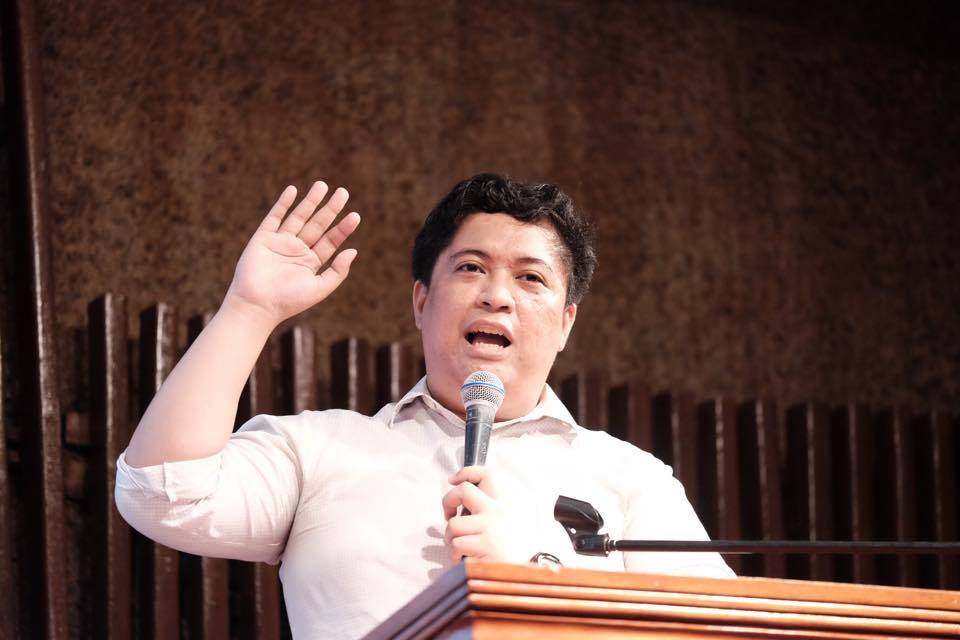Review of ‘Crisis Generates Resistance,’ Volume 1 of the series ‘Peoples’ Struggles against Oppression and Exploitation, Selected Writings, 2009-2015’
By Marjohara Tucay
Kabataan Partylist National President
Coming from the tradition of radical activist student journalism espoused and continued up to this day by the Philippine Collegian, official student publication of the UP, I have learned to write and critique works – from artworks to literary pieces – under the lens of revolutionary aesthetics. Writing the occasional cultural review for the Collegian back in my university days meant testing works for their revolutionary potential.
Higit sa porma at paggamit ng lengwahe, halimbawa, ang isang akda o likhang sining ay sinisipat gamit ang pagsasakonteksto at pagpapalalim sa pinagmumulan nitong kasaysayan. Higit sa pagsukat ng ritmo at indayog ng mga salita, binabaling ang kritisismo sa pagiging malay ng isang akda sa nangingibabaw na kontradiksyon ng mga uri. At higit sa lahat ng ito, ang kritisismo sa padron ng rebolusyunaryong estetika ay nagtutuon ng higit na atensyon sa kakayanan ng prosa o anumang likhang sining na makapukaw at makapagpakilos.
But how does one place Prof. Jose Maria Sison’s work under the rigorous test for revolutionary potential, if his body of work is in itself a detailed chronicle of the revolution, and the man himself is central to the struggle?
Prof. Sison’s latest book “Crisis Generates Resistance,” the first volume in the new series entitled “Peoples’ Struggles against Oppression and Exploitation, Selected Writings, 2009-2015” is not only a work of art that can be digested and mused upon. One need not dissect the choice of words and the turns of phrase in Prof. Sison’s work to find nuggets of revolution. His writings shout, in clear and unequivocal terms, the need to continue arousing, organizing, and mobilizing among various sectors of society to attain genuine social change. He speaks of the need for revolution, not in the subdued tones typical of the contemporary art scene – but in a loud, explicit, and unmistakable manner.
May pangangailangan ang kabataan para sa ganitong tipo ng babasahin – progresibo, matalas, at direktang nakapupukaw at nakapagpapakilos. Sa kasalukuyan, marami sa ating mga manunulat at artista, maging iyong mga progresibo at mulat, ay pinipiling sumakay sa agos ng kontemporaryong kultura. Maraming ulit na akong nakabasa, nakarinig, o nakapanood ng mga akda o likhang-sining na nararapat sana’y may malaking rebolusyunaryong potensyal, ngunit halata ang pagpipigil, ang malay na pagpapalabnaw. May hibo man ng pagiging progresibo, nakukupot ang marami sa pagiging pabulong ng radikalismo, ng pahapyaw at patagong pulitikal na laman sa mga akda. Sa pagnanais na maging “hip” at “in” sa pananaw ng kulturang popular, lumalabnaw ang mensahe – maging ang potensyal na makapukaw at direktang makapagpakilos.
Sa panahong pilit na pinaiikli ng dominanteng kultura maging ang attention span ng mga mambabasa, sa unang tingin ay mahirap sundan ang lubid ng pagsasalaysay ni Prof. Sison. Wala itong palamuti o pagbabalatkayo. Hindi ito naghahabi ng pantasya. Bagkus, ang mga sanaysay na gaya nito ay naglalahad ng katotohanan – ng krisis na kinakaharap ng bansa at ng mundo sa panahon ng pag-igting ng kapitalismo. Sa gayon, tungkulin ng mga progresibong manunulat na sanayin ang kasalukuyang henerasyon ng mga kabataang aktibista na aralin, basahin, at pahalagahan ang ganitong tipo ng mga sulatin.
Prof. Sison’s style of writing – clear, point-blank, and agitating – a style of writing also reflected in the revolutionary paper Ang Bayan – is a style that many of us in the youth and student movement now aspire to. As millennials, a generation raised in the age of the Internet, we have been constantly subjected to the aspirations of popular culture – the culture of instant gratification, the cult of consumerism. As budding progressive writers, we have come to realize the urgent need to turn to revolutionary writings like that of Prof. Sison not only as a way to counteract the dominant consumerist culture, but to regain a sense of radicalism unsullied by the passing fads and distractions of the present digital age. At a time when the voices of dissent continue to be cornered and pushed farther to the margins of political space, we need to regain that militant and assertive style of writing, both in form and in substance. At a time when political writings are considered trite and lackluster by the dominant culture, we must rise above the momentary distractions, and see the importance of asserting the need for agitating political discussions.
Prof. Sison’s essays are not mere musings – they are, in fact, clear instructions towards advancing the people’s struggle for genuine social change. ‘Crisis Generates Resistance’ is not only an apt title to this collection of essays and messages – it is also a succinct explanation of how and why the revolution continues to grow.
The period covered by this book – 2009-2010 – is especially important for many of the current crop of full-time youth activists. For me and my contemporaries in the student movement, these years represent the resurgence of activism and militancy not only in the UP but in other major colleges and universities in the Philippines as well. These were years when the current batch of youth leaders were radicalized. These were the years when the youth and student movement successfully launched nationally-coordinated student strikes and protests to fight against tuition hikes and the waning Arroyo regime.
Looking back, many of the essays included in this volume were essential reading material for us fledgling activists back then. Essays such as “What the People Can and Must Do about the Financial and Economic Crisis” and “Salient Points of the International Situation” and their many variations were widely discussed in the wake of the 2008 US financial crisis. At a time when the youth was struggling to comprehend the subprime mortgage crisis, Prof. Sison’s analyses were instrumental in forging sharp critiques that flowed into discussions in university corridors, and writings published in campus papers.
This new volume also contains essential reading material for the youth and student movement in the years to come. Messages delivered by Prof. Sison to the Filipino youth, including “Continue the Great Tradition of the Progressive and Patriotic Youth” and “Carry Forward the Revolutionary Tradition of Kabataang Makabayan” embolden the current and upcoming batches of youth activists to focus on expanding the membership of mass organizations, and to continually adhere to the fundamental analysis of the semicolonial and semifeudal state of the Philippine ruling system.
In his frequent messages to the Filipino youth, many of which are published here, he captures the fundamental problem besieging our sector. In his message to the League of Filipino Students in 2009, he said, “The Filipino student youth are victims not only to the rising costs of living and study but also to the reactionary content of education or miseducation. They are systematically diverted from consciousness that is patriotic, scientific and people-oriented. Those who control the educational system, the mass media and other institutions seek to alienate them from the people’s demand for national independence, democracy, social justice, development and international solidarity and peace against imperialism and all reaction.”
Ang nabanggit kong quote ay sa katotohana’y buod ng nagpapatuloy na laban ng kabataan hanggang sa kasalukuyan. Ang patuloy na deregulasyon at komersyalisasyon ng edukasyon, na nagbunsod ng lumolobong presyo ng matrikula at iba pang bayarin; ang patuloy na pagkaagnas ng sistema ng edukasyon, na batid sa mga pagbabago sa kurikulum, partikular sa pagpapatupad ng sistemang K to 12; ang patuloy na ‘misedukasyon’ ng kabataan sa pamamagitan ng pagtanggal ng patriyotiko, siyentipiko, at makamasang aralin sa mga paaralan – ito mismo ang mga isyung patuloy na kinakaharap ng sektor ng kabataan sa panahong tumitindi ang paghambalos ng neoliberal na mga patakaran sa edukasyon.
Sa ganitong diwa, marapat lamang na isama ang marami sa mga sanaysay ni Prof. Sison sa aklat na ito sa kurikulum sa gawaing edukasyon ng mga pangmasang organisasyon ng kabataan.
The book also contains several essays and interviews instructive in the manner in which the progressive movement should tackle and handle the upcoming 2016 presidential elections. There is a great need for us to review certain essays in this book to guide us as we enter the electoral period.
As president of Kabataan Partylist, one of the member party-lists of Makabayan, I find Prof. Sison’s words in his message to the founding assembly of the Makabayan Coalition entitled “Consolidate the People’s Gains in the Electoral Struggle,” enlightening. He said, “To be truly a political force advancing the politics of change and reforms, Makabayan should always be close to the people, especially to the toiling masses of workers and peasants, learning from them, trusting them and relying on them. By following such mass line, you can learn how best to engage in political education, increase your organized strength and mobilize the masses for denouncing the oppressive and exploitative character and policies of the reactionary government and demanding immediate basic social, economic, political and cultural reforms in the direction of fundamental social transformation.”
The series of interviews granted to alternative media outfits Bulatlat and Pinoy Weekly also provide us with a concrete guide on how to handle alliances with dominant parties and what to expect in the aftermath of the reactionary electoral exercise. Prof. Sison grimly reminds us of the illusion of change brought about by the reactionary elections: “Without a strong mass movement to advance their national and democratic interests, the Filipino people will continue to be oppressed and exploited with impunity by the foreign monopolies, the big compradors-landlords and the corrupt bureaucrats. The socioeconomic and political crisis of the ruling system will continue to worsen. The ruling clique and the ruling classes of big compradors and landlords will become more incapable than ever of ruling in the old way.”
Finally, this new volume also contains essential reminders for the Filipino youth of the urgent need to intensify the struggle for national liberation and democracy. Prof. Sison explains to us, in clear and uncompromising words, why the need to intensify the revolution remains, and why there is a need to organize thousands of Filipino youth to become advanced activists and advocates of the revolutionary cause.
To this end, we in the youth and student movement commend Prof. Sison for the publication of this new volume of essays that will surely be a tour de force that will greatly propel the revolution forward. On behalf of the youth sector, we accept the challenge that this new book poses – and that is to intensify the struggle for national democracy.###

